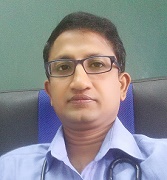Rural Round-up: A PHC model in rural Sri Lanka
Community-Oriented Primary Care - a model for Primary Care in a limited resource setting.
 Dr Gobith Ratnasingam, a young family doctor and council member of the WONCA Working Party on Rural Practice presents a report of a model for primary care which is being implemented in a rural part of Sri Lanka called “Community-Oriented Primary Care”.
Dr Gobith Ratnasingam, a young family doctor and council member of the WONCA Working Party on Rural Practice presents a report of a model for primary care which is being implemented in a rural part of Sri Lanka called “Community-Oriented Primary Care”.
Sri Lanka is a low middle income country with more than 70% of the population being rural. Primary care services are delivered by both state and private sectors. The state sector is through Medical Officers of Health (MOH); Divisional Hospitals (DHs); Primary Medical Care Units (PMCUs); and Outpatient Departments (OPDs) of base, general and teaching hospitals. The private sector is through part time and full time general practitioners as well as the OPDs of private hospitals. A Medical Officer of Health delivers community based preventive health services while DHs and PMCUs provide institution-based care.
Despite a fairly good primary care delivery system, the continuously increasing dual disease burden of communicable and non-communicable diseases are a real challenge to the overall health sector. Strengthening primary care with active community involvement is considered to be a cost-effective and a sustainable way to lessen this burden. The World Health Organization states that, practising Family Medicine principles is the best way to overcome this burden.
Now Sri Lankan health authorities have also realised the importance of primary care in controlling the NCD related burden. However, lack of resources is considered as a major challenge especially in rural areas.
The “Community-Oriented Primary Care” (COPC) is an option to improve primary care in low resource settings. COPC is defined as a care practice, providing accessible, comprehensive, coordinated, continuous, and accountable health care in a defined community. It includes defining the community, conducting a community diagnosis, developing and implementing an intervention, monitoring the impact of intervention and actively involving the community.
Paving the way for this, the Department of Community and Family Medicine, University of Jaffna (DCFM) developed a model of a primary care delivery system in its project area (Nallur Medical Officer of Health), in 2012. This area mainly covers a rural population of 35000 residents, in 8000 families. DCFM implements COPC by coordinating and motivating health care workers and the general public, which is enhanced by a focal point called the Family Health Centre (FHC). The Family Health Centre is located centrally in the project area and other health care institutions are starting to function in collaborative shared care. Health information is kept in paper-based documents and used for evaluating the outcome of the project and conducting research.
Over six years, the FHC has served patients through clinic and home visits, community screening, health educational events and healthy life style activities. At the same time, FHC conducts regular in-service training to primary care doctors and allied health professionals.
Interviews with various stakeholders indicate that the activities of the FHC are effective and highly valued. However, several challenges confront the FHC and must be addressed. Then the model can optimise activities and serve as a model that can be replicated across the country.
Find out more about this model for primary care from the
linked paper.
Paper presented with permission of lead author Dr Kumaran.